HI5017: Managerial Accounting Systems Evaluation Report Analysis
VerifiedAdded on 2022/10/06
|11
|2822
|8
Report
AI Summary
This report critically evaluates the role and relevance of Management Accounting Systems (MAS) in supporting managerial decision-making within contemporary business organizations. It examines the practical application of MAS through the analysis of selected journal articles and a case study of a multinational manufacturing company. The report identifies key MAS techniques such as Activity Based Costing (ABC), Balanced Scorecard (BSC), and Just In Time (JIT), assessing their impact on cost control, financial reporting, and overall business strategy. The analysis compares findings from different sources, highlighting both the benefits and challenges associated with MAS adoption, including the influence of business culture and size. The report concludes that while MAS are beneficial in today's competitive environment, their successful implementation requires careful consideration of specific business needs and strategic internal analysis. It emphasizes the importance of aligning MAS techniques with operational processes and the differing relevance of MAS information for operational versus strategic managers, offering insights for management accountants to achieve success in the use of these methods. The report is based on the assignment brief for the HI5017 Managerial Accounting course, T2 2019, from Holmes Institute.
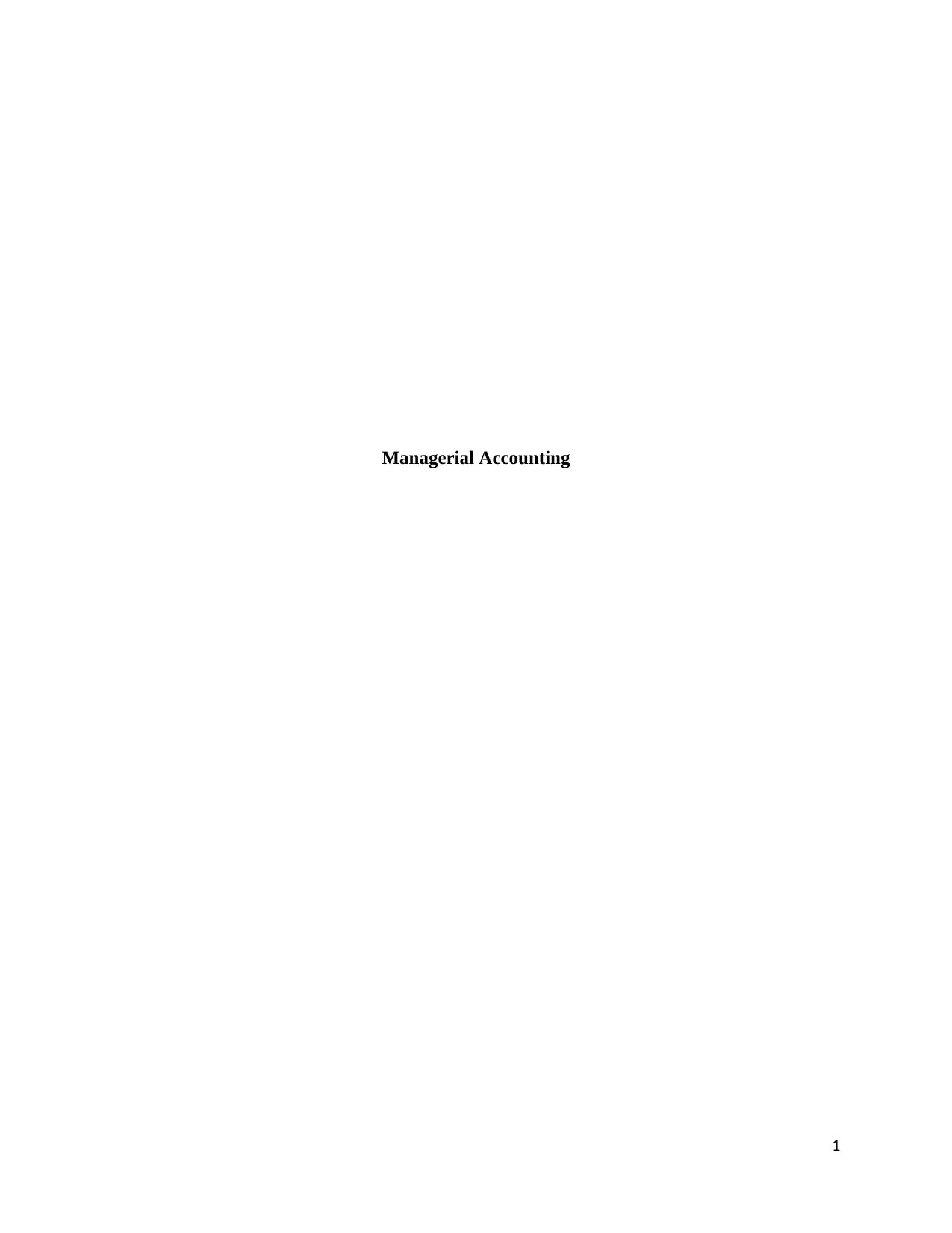
Managerial Accounting
1
1
Paraphrase This Document
Need a fresh take? Get an instant paraphrase of this document with our AI Paraphraser
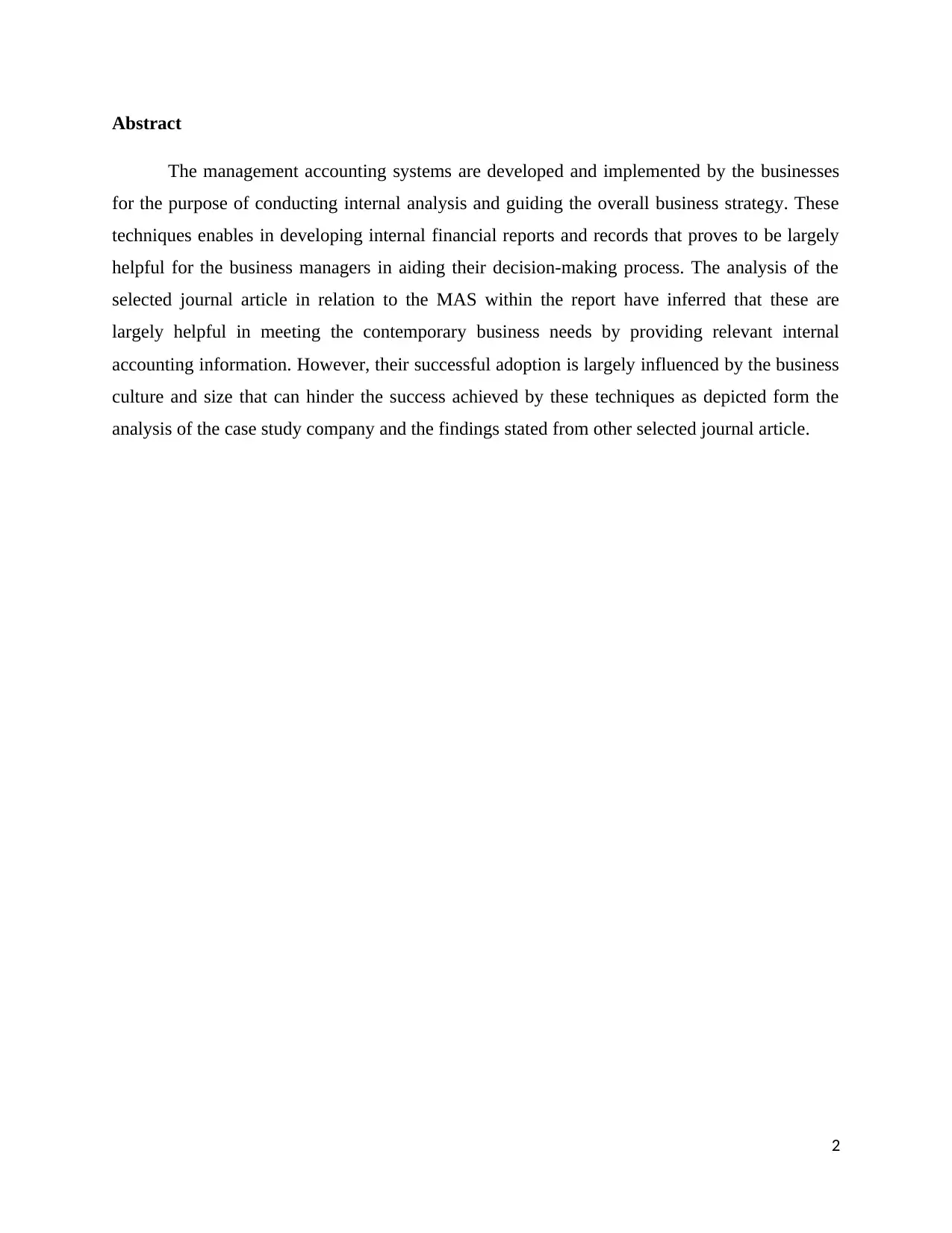
Abstract
The management accounting systems are developed and implemented by the businesses
for the purpose of conducting internal analysis and guiding the overall business strategy. These
techniques enables in developing internal financial reports and records that proves to be largely
helpful for the business managers in aiding their decision-making process. The analysis of the
selected journal article in relation to the MAS within the report have inferred that these are
largely helpful in meeting the contemporary business needs by providing relevant internal
accounting information. However, their successful adoption is largely influenced by the business
culture and size that can hinder the success achieved by these techniques as depicted form the
analysis of the case study company and the findings stated from other selected journal article.
2
The management accounting systems are developed and implemented by the businesses
for the purpose of conducting internal analysis and guiding the overall business strategy. These
techniques enables in developing internal financial reports and records that proves to be largely
helpful for the business managers in aiding their decision-making process. The analysis of the
selected journal article in relation to the MAS within the report have inferred that these are
largely helpful in meeting the contemporary business needs by providing relevant internal
accounting information. However, their successful adoption is largely influenced by the business
culture and size that can hinder the success achieved by these techniques as depicted form the
analysis of the case study company and the findings stated from other selected journal article.
2
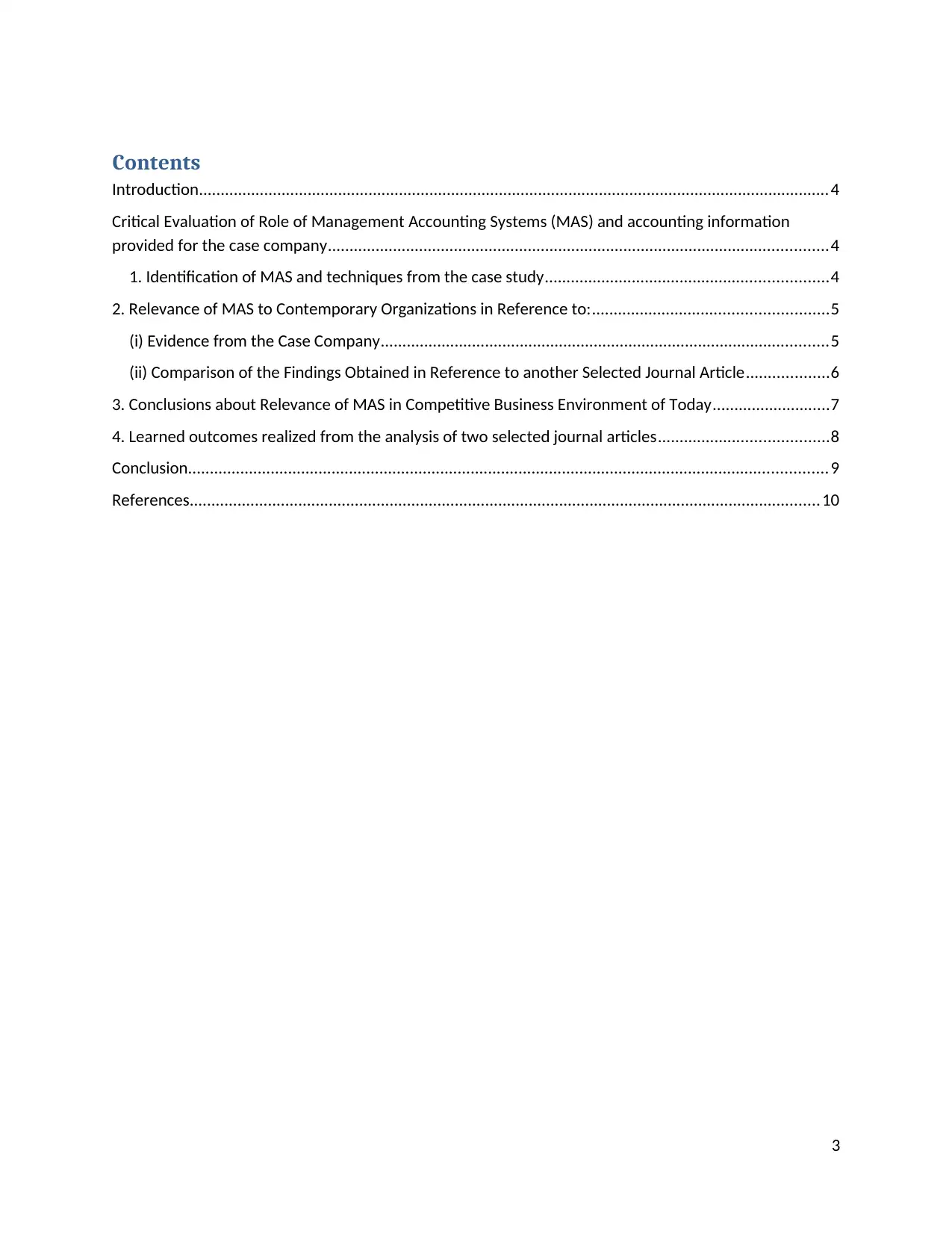
Contents
Introduction.................................................................................................................................................4
Critical Evaluation of Role of Management Accounting Systems (MAS) and accounting information
provided for the case company...................................................................................................................4
1. Identification of MAS and techniques from the case study.................................................................4
2. Relevance of MAS to Contemporary Organizations in Reference to:......................................................5
(i) Evidence from the Case Company.......................................................................................................5
(ii) Comparison of the Findings Obtained in Reference to another Selected Journal Article...................6
3. Conclusions about Relevance of MAS in Competitive Business Environment of Today...........................7
4. Learned outcomes realized from the analysis of two selected journal articles.......................................8
Conclusion...................................................................................................................................................9
References.................................................................................................................................................10
3
Introduction.................................................................................................................................................4
Critical Evaluation of Role of Management Accounting Systems (MAS) and accounting information
provided for the case company...................................................................................................................4
1. Identification of MAS and techniques from the case study.................................................................4
2. Relevance of MAS to Contemporary Organizations in Reference to:......................................................5
(i) Evidence from the Case Company.......................................................................................................5
(ii) Comparison of the Findings Obtained in Reference to another Selected Journal Article...................6
3. Conclusions about Relevance of MAS in Competitive Business Environment of Today...........................7
4. Learned outcomes realized from the analysis of two selected journal articles.......................................8
Conclusion...................................................................................................................................................9
References.................................................................................................................................................10
3
⊘ This is a preview!⊘
Do you want full access?
Subscribe today to unlock all pages.

Trusted by 1+ million students worldwide
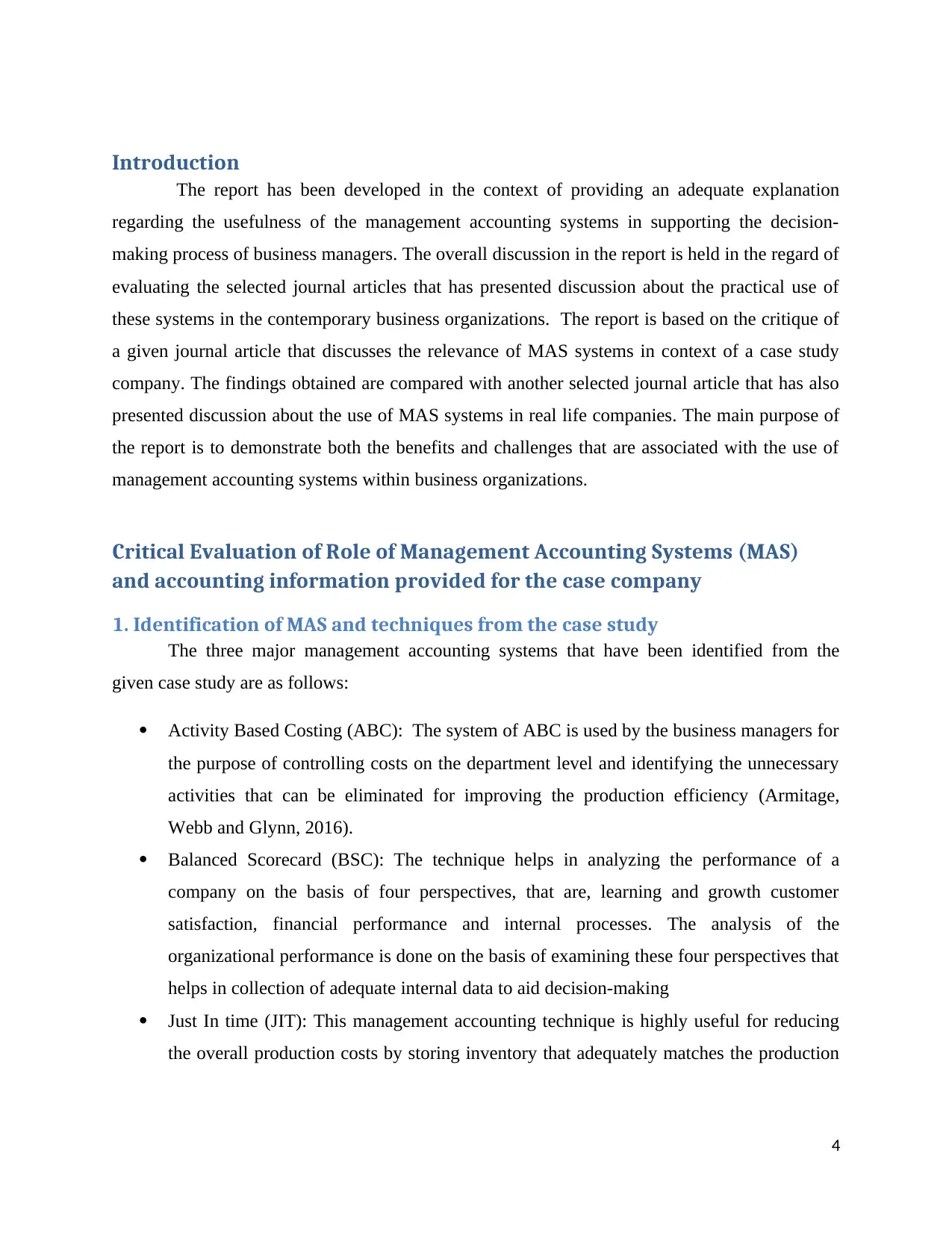
Introduction
The report has been developed in the context of providing an adequate explanation
regarding the usefulness of the management accounting systems in supporting the decision-
making process of business managers. The overall discussion in the report is held in the regard of
evaluating the selected journal articles that has presented discussion about the practical use of
these systems in the contemporary business organizations. The report is based on the critique of
a given journal article that discusses the relevance of MAS systems in context of a case study
company. The findings obtained are compared with another selected journal article that has also
presented discussion about the use of MAS systems in real life companies. The main purpose of
the report is to demonstrate both the benefits and challenges that are associated with the use of
management accounting systems within business organizations.
Critical Evaluation of Role of Management Accounting Systems (MAS)
and accounting information provided for the case company
1. Identification of MAS and techniques from the case study
The three major management accounting systems that have been identified from the
given case study are as follows:
Activity Based Costing (ABC): The system of ABC is used by the business managers for
the purpose of controlling costs on the department level and identifying the unnecessary
activities that can be eliminated for improving the production efficiency (Armitage,
Webb and Glynn, 2016).
Balanced Scorecard (BSC): The technique helps in analyzing the performance of a
company on the basis of four perspectives, that are, learning and growth customer
satisfaction, financial performance and internal processes. The analysis of the
organizational performance is done on the basis of examining these four perspectives that
helps in collection of adequate internal data to aid decision-making
Just In time (JIT): This management accounting technique is highly useful for reducing
the overall production costs by storing inventory that adequately matches the production
4
The report has been developed in the context of providing an adequate explanation
regarding the usefulness of the management accounting systems in supporting the decision-
making process of business managers. The overall discussion in the report is held in the regard of
evaluating the selected journal articles that has presented discussion about the practical use of
these systems in the contemporary business organizations. The report is based on the critique of
a given journal article that discusses the relevance of MAS systems in context of a case study
company. The findings obtained are compared with another selected journal article that has also
presented discussion about the use of MAS systems in real life companies. The main purpose of
the report is to demonstrate both the benefits and challenges that are associated with the use of
management accounting systems within business organizations.
Critical Evaluation of Role of Management Accounting Systems (MAS)
and accounting information provided for the case company
1. Identification of MAS and techniques from the case study
The three major management accounting systems that have been identified from the
given case study are as follows:
Activity Based Costing (ABC): The system of ABC is used by the business managers for
the purpose of controlling costs on the department level and identifying the unnecessary
activities that can be eliminated for improving the production efficiency (Armitage,
Webb and Glynn, 2016).
Balanced Scorecard (BSC): The technique helps in analyzing the performance of a
company on the basis of four perspectives, that are, learning and growth customer
satisfaction, financial performance and internal processes. The analysis of the
organizational performance is done on the basis of examining these four perspectives that
helps in collection of adequate internal data to aid decision-making
Just In time (JIT): This management accounting technique is highly useful for reducing
the overall production costs by storing inventory that adequately matches the production
4
Paraphrase This Document
Need a fresh take? Get an instant paraphrase of this document with our AI Paraphraser
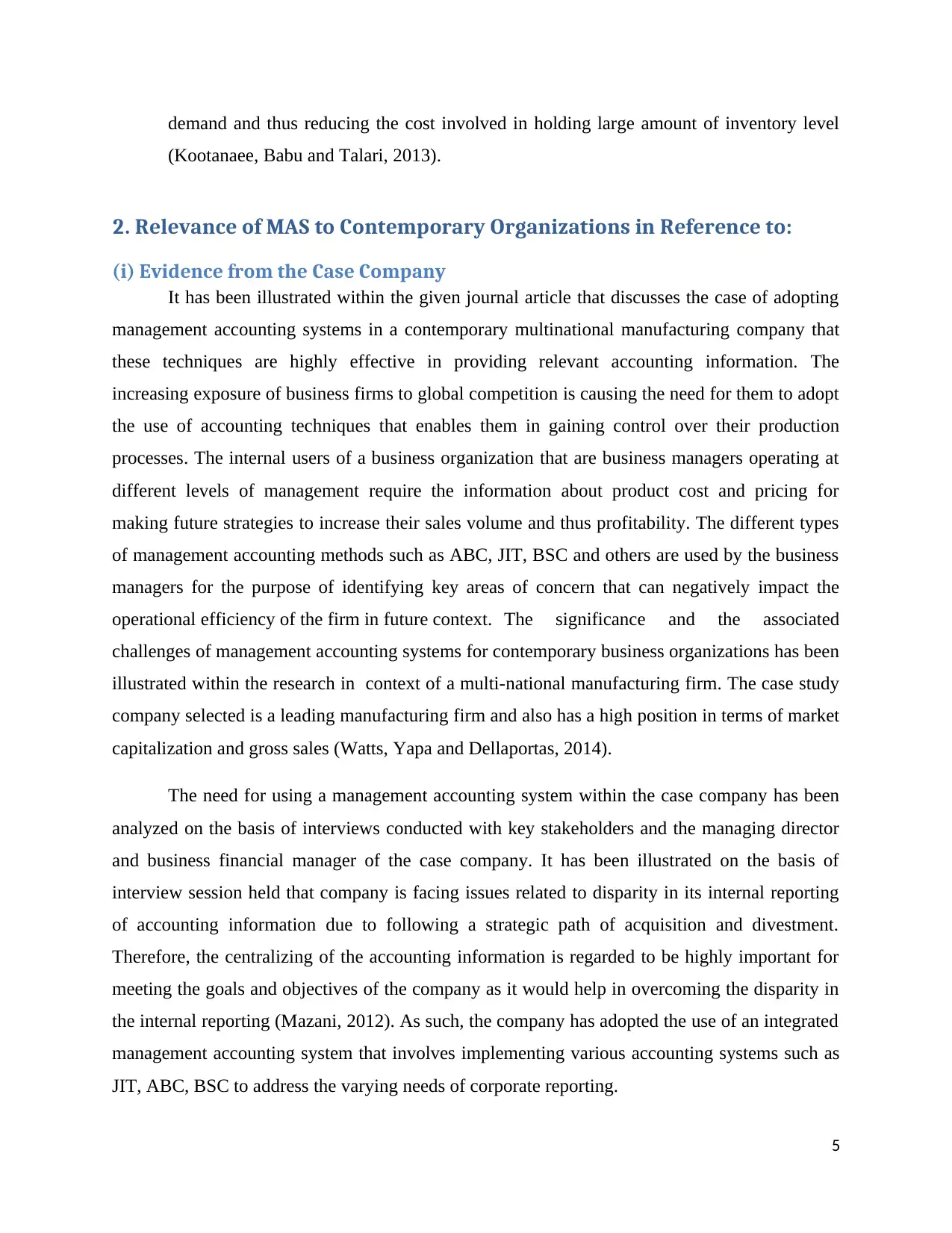
demand and thus reducing the cost involved in holding large amount of inventory level
(Kootanaee, Babu and Talari, 2013).
2. Relevance of MAS to Contemporary Organizations in Reference to:
(i) Evidence from the Case Company
It has been illustrated within the given journal article that discusses the case of adopting
management accounting systems in a contemporary multinational manufacturing company that
these techniques are highly effective in providing relevant accounting information. The
increasing exposure of business firms to global competition is causing the need for them to adopt
the use of accounting techniques that enables them in gaining control over their production
processes. The internal users of a business organization that are business managers operating at
different levels of management require the information about product cost and pricing for
making future strategies to increase their sales volume and thus profitability. The different types
of management accounting methods such as ABC, JIT, BSC and others are used by the business
managers for the purpose of identifying key areas of concern that can negatively impact the
operational efficiency of the firm in future context. The significance and the associated
challenges of management accounting systems for contemporary business organizations has been
illustrated within the research in context of a multi-national manufacturing firm. The case study
company selected is a leading manufacturing firm and also has a high position in terms of market
capitalization and gross sales (Watts, Yapa and Dellaportas, 2014).
The need for using a management accounting system within the case company has been
analyzed on the basis of interviews conducted with key stakeholders and the managing director
and business financial manager of the case company. It has been illustrated on the basis of
interview session held that company is facing issues related to disparity in its internal reporting
of accounting information due to following a strategic path of acquisition and divestment.
Therefore, the centralizing of the accounting information is regarded to be highly important for
meeting the goals and objectives of the company as it would help in overcoming the disparity in
the internal reporting (Mazani, 2012). As such, the company has adopted the use of an integrated
management accounting system that involves implementing various accounting systems such as
JIT, ABC, BSC to address the varying needs of corporate reporting.
5
(Kootanaee, Babu and Talari, 2013).
2. Relevance of MAS to Contemporary Organizations in Reference to:
(i) Evidence from the Case Company
It has been illustrated within the given journal article that discusses the case of adopting
management accounting systems in a contemporary multinational manufacturing company that
these techniques are highly effective in providing relevant accounting information. The
increasing exposure of business firms to global competition is causing the need for them to adopt
the use of accounting techniques that enables them in gaining control over their production
processes. The internal users of a business organization that are business managers operating at
different levels of management require the information about product cost and pricing for
making future strategies to increase their sales volume and thus profitability. The different types
of management accounting methods such as ABC, JIT, BSC and others are used by the business
managers for the purpose of identifying key areas of concern that can negatively impact the
operational efficiency of the firm in future context. The significance and the associated
challenges of management accounting systems for contemporary business organizations has been
illustrated within the research in context of a multi-national manufacturing firm. The case study
company selected is a leading manufacturing firm and also has a high position in terms of market
capitalization and gross sales (Watts, Yapa and Dellaportas, 2014).
The need for using a management accounting system within the case company has been
analyzed on the basis of interviews conducted with key stakeholders and the managing director
and business financial manager of the case company. It has been illustrated on the basis of
interview session held that company is facing issues related to disparity in its internal reporting
of accounting information due to following a strategic path of acquisition and divestment.
Therefore, the centralizing of the accounting information is regarded to be highly important for
meeting the goals and objectives of the company as it would help in overcoming the disparity in
the internal reporting (Mazani, 2012). As such, the company has adopted the use of an integrated
management accounting system that involves implementing various accounting systems such as
JIT, ABC, BSC to address the varying needs of corporate reporting.
5
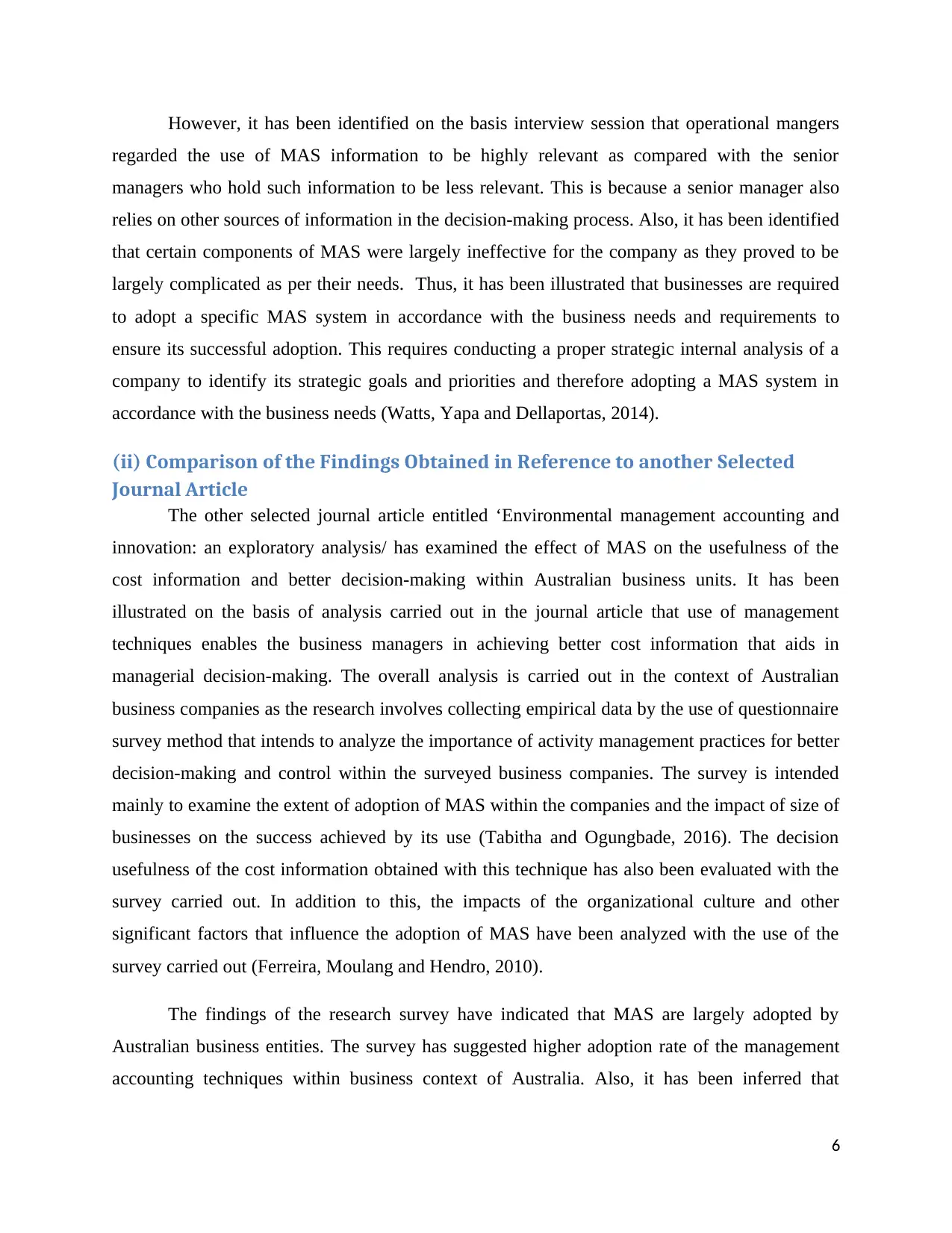
However, it has been identified on the basis interview session that operational mangers
regarded the use of MAS information to be highly relevant as compared with the senior
managers who hold such information to be less relevant. This is because a senior manager also
relies on other sources of information in the decision-making process. Also, it has been identified
that certain components of MAS were largely ineffective for the company as they proved to be
largely complicated as per their needs. Thus, it has been illustrated that businesses are required
to adopt a specific MAS system in accordance with the business needs and requirements to
ensure its successful adoption. This requires conducting a proper strategic internal analysis of a
company to identify its strategic goals and priorities and therefore adopting a MAS system in
accordance with the business needs (Watts, Yapa and Dellaportas, 2014).
(ii) Comparison of the Findings Obtained in Reference to another Selected
Journal Article
The other selected journal article entitled ‘Environmental management accounting and
innovation: an exploratory analysis/ has examined the effect of MAS on the usefulness of the
cost information and better decision-making within Australian business units. It has been
illustrated on the basis of analysis carried out in the journal article that use of management
techniques enables the business managers in achieving better cost information that aids in
managerial decision-making. The overall analysis is carried out in the context of Australian
business companies as the research involves collecting empirical data by the use of questionnaire
survey method that intends to analyze the importance of activity management practices for better
decision-making and control within the surveyed business companies. The survey is intended
mainly to examine the extent of adoption of MAS within the companies and the impact of size of
businesses on the success achieved by its use (Tabitha and Ogungbade, 2016). The decision
usefulness of the cost information obtained with this technique has also been evaluated with the
survey carried out. In addition to this, the impacts of the organizational culture and other
significant factors that influence the adoption of MAS have been analyzed with the use of the
survey carried out (Ferreira, Moulang and Hendro, 2010).
The findings of the research survey have indicated that MAS are largely adopted by
Australian business entities. The survey has suggested higher adoption rate of the management
accounting techniques within business context of Australia. Also, it has been inferred that
6
regarded the use of MAS information to be highly relevant as compared with the senior
managers who hold such information to be less relevant. This is because a senior manager also
relies on other sources of information in the decision-making process. Also, it has been identified
that certain components of MAS were largely ineffective for the company as they proved to be
largely complicated as per their needs. Thus, it has been illustrated that businesses are required
to adopt a specific MAS system in accordance with the business needs and requirements to
ensure its successful adoption. This requires conducting a proper strategic internal analysis of a
company to identify its strategic goals and priorities and therefore adopting a MAS system in
accordance with the business needs (Watts, Yapa and Dellaportas, 2014).
(ii) Comparison of the Findings Obtained in Reference to another Selected
Journal Article
The other selected journal article entitled ‘Environmental management accounting and
innovation: an exploratory analysis/ has examined the effect of MAS on the usefulness of the
cost information and better decision-making within Australian business units. It has been
illustrated on the basis of analysis carried out in the journal article that use of management
techniques enables the business managers in achieving better cost information that aids in
managerial decision-making. The overall analysis is carried out in the context of Australian
business companies as the research involves collecting empirical data by the use of questionnaire
survey method that intends to analyze the importance of activity management practices for better
decision-making and control within the surveyed business companies. The survey is intended
mainly to examine the extent of adoption of MAS within the companies and the impact of size of
businesses on the success achieved by its use (Tabitha and Ogungbade, 2016). The decision
usefulness of the cost information obtained with this technique has also been evaluated with the
survey carried out. In addition to this, the impacts of the organizational culture and other
significant factors that influence the adoption of MAS have been analyzed with the use of the
survey carried out (Ferreira, Moulang and Hendro, 2010).
The findings of the research survey have indicated that MAS are largely adopted by
Australian business entities. The survey has suggested higher adoption rate of the management
accounting techniques within business context of Australia. Also, it has been inferred that
6
⊘ This is a preview!⊘
Do you want full access?
Subscribe today to unlock all pages.

Trusted by 1+ million students worldwide
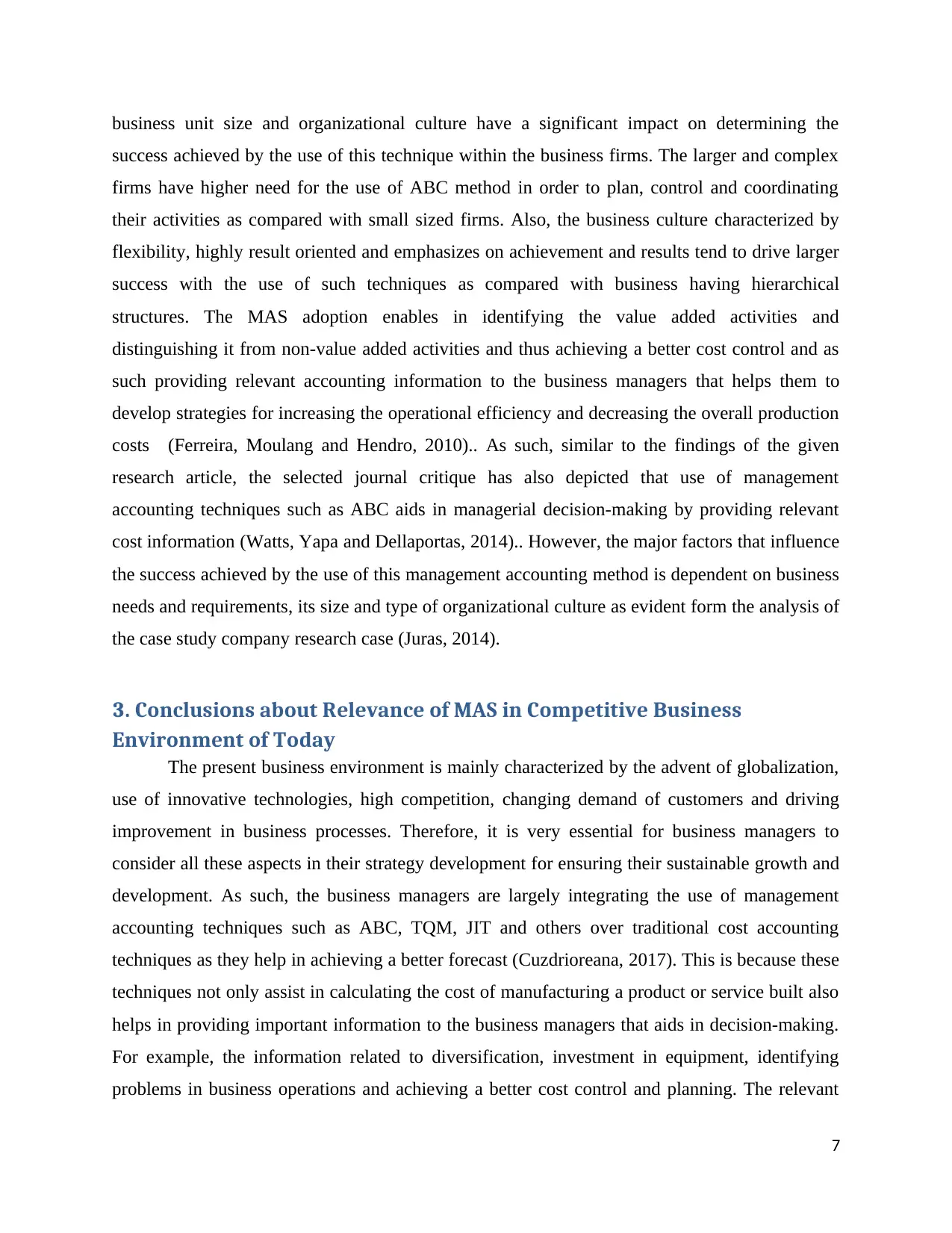
business unit size and organizational culture have a significant impact on determining the
success achieved by the use of this technique within the business firms. The larger and complex
firms have higher need for the use of ABC method in order to plan, control and coordinating
their activities as compared with small sized firms. Also, the business culture characterized by
flexibility, highly result oriented and emphasizes on achievement and results tend to drive larger
success with the use of such techniques as compared with business having hierarchical
structures. The MAS adoption enables in identifying the value added activities and
distinguishing it from non-value added activities and thus achieving a better cost control and as
such providing relevant accounting information to the business managers that helps them to
develop strategies for increasing the operational efficiency and decreasing the overall production
costs (Ferreira, Moulang and Hendro, 2010).. As such, similar to the findings of the given
research article, the selected journal critique has also depicted that use of management
accounting techniques such as ABC aids in managerial decision-making by providing relevant
cost information (Watts, Yapa and Dellaportas, 2014).. However, the major factors that influence
the success achieved by the use of this management accounting method is dependent on business
needs and requirements, its size and type of organizational culture as evident form the analysis of
the case study company research case (Juras, 2014).
3. Conclusions about Relevance of MAS in Competitive Business
Environment of Today
The present business environment is mainly characterized by the advent of globalization,
use of innovative technologies, high competition, changing demand of customers and driving
improvement in business processes. Therefore, it is very essential for business managers to
consider all these aspects in their strategy development for ensuring their sustainable growth and
development. As such, the business managers are largely integrating the use of management
accounting techniques such as ABC, TQM, JIT and others over traditional cost accounting
techniques as they help in achieving a better forecast (Cuzdrioreana, 2017). This is because these
techniques not only assist in calculating the cost of manufacturing a product or service built also
helps in providing important information to the business managers that aids in decision-making.
For example, the information related to diversification, investment in equipment, identifying
problems in business operations and achieving a better cost control and planning. The relevant
7
success achieved by the use of this technique within the business firms. The larger and complex
firms have higher need for the use of ABC method in order to plan, control and coordinating
their activities as compared with small sized firms. Also, the business culture characterized by
flexibility, highly result oriented and emphasizes on achievement and results tend to drive larger
success with the use of such techniques as compared with business having hierarchical
structures. The MAS adoption enables in identifying the value added activities and
distinguishing it from non-value added activities and thus achieving a better cost control and as
such providing relevant accounting information to the business managers that helps them to
develop strategies for increasing the operational efficiency and decreasing the overall production
costs (Ferreira, Moulang and Hendro, 2010).. As such, similar to the findings of the given
research article, the selected journal critique has also depicted that use of management
accounting techniques such as ABC aids in managerial decision-making by providing relevant
cost information (Watts, Yapa and Dellaportas, 2014).. However, the major factors that influence
the success achieved by the use of this management accounting method is dependent on business
needs and requirements, its size and type of organizational culture as evident form the analysis of
the case study company research case (Juras, 2014).
3. Conclusions about Relevance of MAS in Competitive Business
Environment of Today
The present business environment is mainly characterized by the advent of globalization,
use of innovative technologies, high competition, changing demand of customers and driving
improvement in business processes. Therefore, it is very essential for business managers to
consider all these aspects in their strategy development for ensuring their sustainable growth and
development. As such, the business managers are largely integrating the use of management
accounting techniques such as ABC, TQM, JIT and others over traditional cost accounting
techniques as they help in achieving a better forecast (Cuzdrioreana, 2017). This is because these
techniques not only assist in calculating the cost of manufacturing a product or service built also
helps in providing important information to the business managers that aids in decision-making.
For example, the information related to diversification, investment in equipment, identifying
problems in business operations and achieving a better cost control and planning. The relevant
7
Paraphrase This Document
Need a fresh take? Get an instant paraphrase of this document with our AI Paraphraser
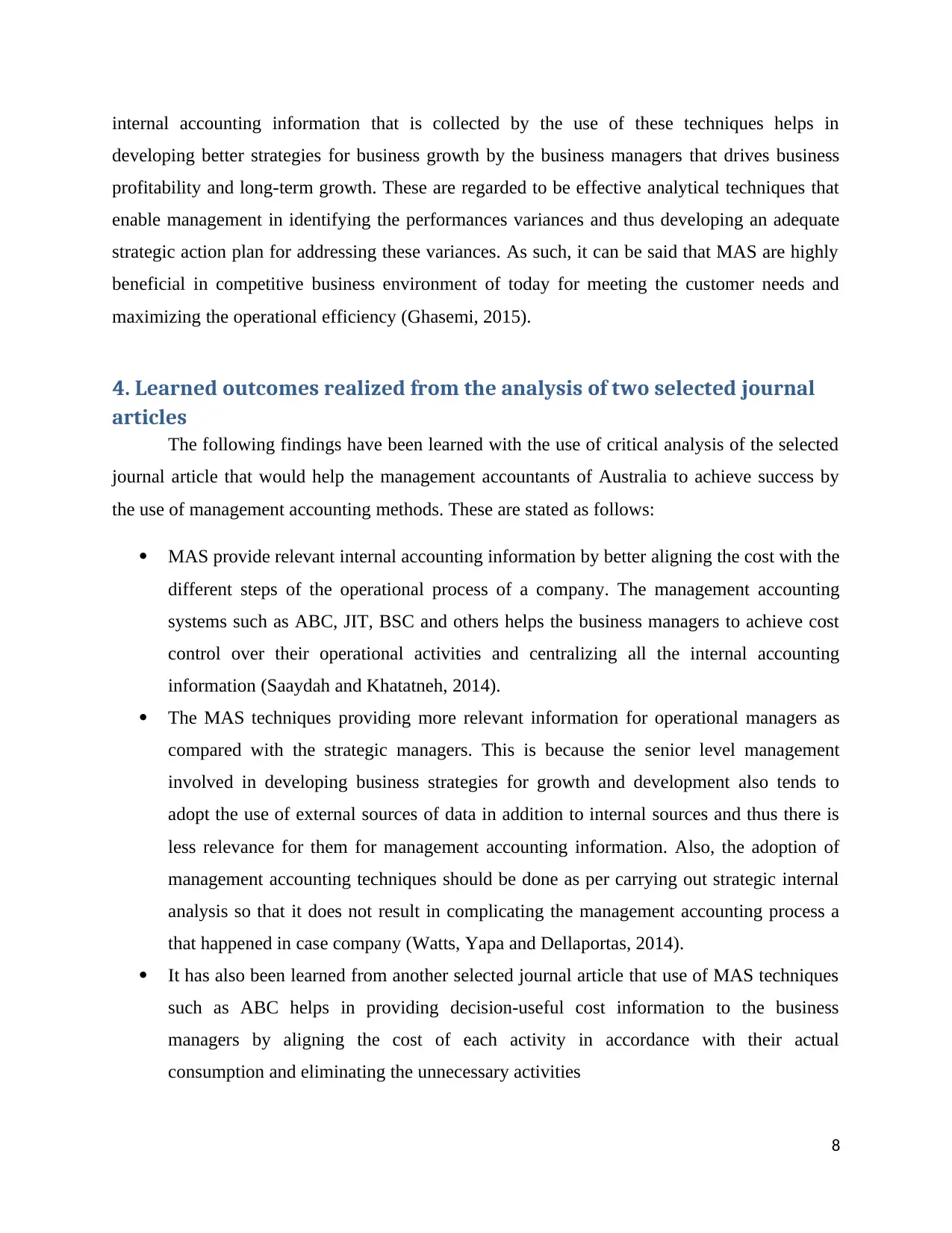
internal accounting information that is collected by the use of these techniques helps in
developing better strategies for business growth by the business managers that drives business
profitability and long-term growth. These are regarded to be effective analytical techniques that
enable management in identifying the performances variances and thus developing an adequate
strategic action plan for addressing these variances. As such, it can be said that MAS are highly
beneficial in competitive business environment of today for meeting the customer needs and
maximizing the operational efficiency (Ghasemi, 2015).
4. Learned outcomes realized from the analysis of two selected journal
articles
The following findings have been learned with the use of critical analysis of the selected
journal article that would help the management accountants of Australia to achieve success by
the use of management accounting methods. These are stated as follows:
MAS provide relevant internal accounting information by better aligning the cost with the
different steps of the operational process of a company. The management accounting
systems such as ABC, JIT, BSC and others helps the business managers to achieve cost
control over their operational activities and centralizing all the internal accounting
information (Saaydah and Khatatneh, 2014).
The MAS techniques providing more relevant information for operational managers as
compared with the strategic managers. This is because the senior level management
involved in developing business strategies for growth and development also tends to
adopt the use of external sources of data in addition to internal sources and thus there is
less relevance for them for management accounting information. Also, the adoption of
management accounting techniques should be done as per carrying out strategic internal
analysis so that it does not result in complicating the management accounting process a
that happened in case company (Watts, Yapa and Dellaportas, 2014).
It has also been learned from another selected journal article that use of MAS techniques
such as ABC helps in providing decision-useful cost information to the business
managers by aligning the cost of each activity in accordance with their actual
consumption and eliminating the unnecessary activities
8
developing better strategies for business growth by the business managers that drives business
profitability and long-term growth. These are regarded to be effective analytical techniques that
enable management in identifying the performances variances and thus developing an adequate
strategic action plan for addressing these variances. As such, it can be said that MAS are highly
beneficial in competitive business environment of today for meeting the customer needs and
maximizing the operational efficiency (Ghasemi, 2015).
4. Learned outcomes realized from the analysis of two selected journal
articles
The following findings have been learned with the use of critical analysis of the selected
journal article that would help the management accountants of Australia to achieve success by
the use of management accounting methods. These are stated as follows:
MAS provide relevant internal accounting information by better aligning the cost with the
different steps of the operational process of a company. The management accounting
systems such as ABC, JIT, BSC and others helps the business managers to achieve cost
control over their operational activities and centralizing all the internal accounting
information (Saaydah and Khatatneh, 2014).
The MAS techniques providing more relevant information for operational managers as
compared with the strategic managers. This is because the senior level management
involved in developing business strategies for growth and development also tends to
adopt the use of external sources of data in addition to internal sources and thus there is
less relevance for them for management accounting information. Also, the adoption of
management accounting techniques should be done as per carrying out strategic internal
analysis so that it does not result in complicating the management accounting process a
that happened in case company (Watts, Yapa and Dellaportas, 2014).
It has also been learned from another selected journal article that use of MAS techniques
such as ABC helps in providing decision-useful cost information to the business
managers by aligning the cost of each activity in accordance with their actual
consumption and eliminating the unnecessary activities
8
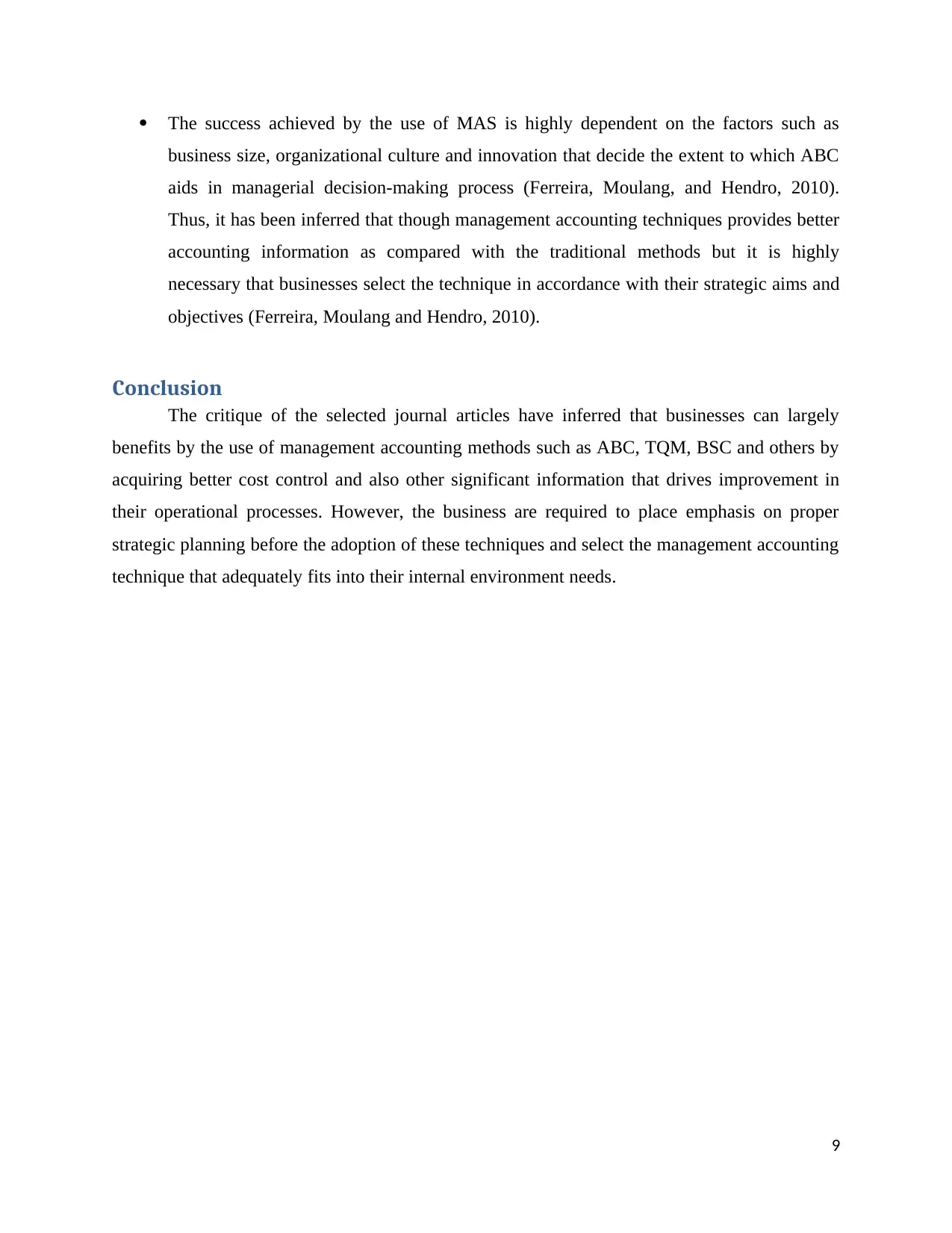
The success achieved by the use of MAS is highly dependent on the factors such as
business size, organizational culture and innovation that decide the extent to which ABC
aids in managerial decision-making process (Ferreira, Moulang, and Hendro, 2010).
Thus, it has been inferred that though management accounting techniques provides better
accounting information as compared with the traditional methods but it is highly
necessary that businesses select the technique in accordance with their strategic aims and
objectives (Ferreira, Moulang and Hendro, 2010).
Conclusion
The critique of the selected journal articles have inferred that businesses can largely
benefits by the use of management accounting methods such as ABC, TQM, BSC and others by
acquiring better cost control and also other significant information that drives improvement in
their operational processes. However, the business are required to place emphasis on proper
strategic planning before the adoption of these techniques and select the management accounting
technique that adequately fits into their internal environment needs.
9
business size, organizational culture and innovation that decide the extent to which ABC
aids in managerial decision-making process (Ferreira, Moulang, and Hendro, 2010).
Thus, it has been inferred that though management accounting techniques provides better
accounting information as compared with the traditional methods but it is highly
necessary that businesses select the technique in accordance with their strategic aims and
objectives (Ferreira, Moulang and Hendro, 2010).
Conclusion
The critique of the selected journal articles have inferred that businesses can largely
benefits by the use of management accounting methods such as ABC, TQM, BSC and others by
acquiring better cost control and also other significant information that drives improvement in
their operational processes. However, the business are required to place emphasis on proper
strategic planning before the adoption of these techniques and select the management accounting
technique that adequately fits into their internal environment needs.
9
⊘ This is a preview!⊘
Do you want full access?
Subscribe today to unlock all pages.

Trusted by 1+ million students worldwide
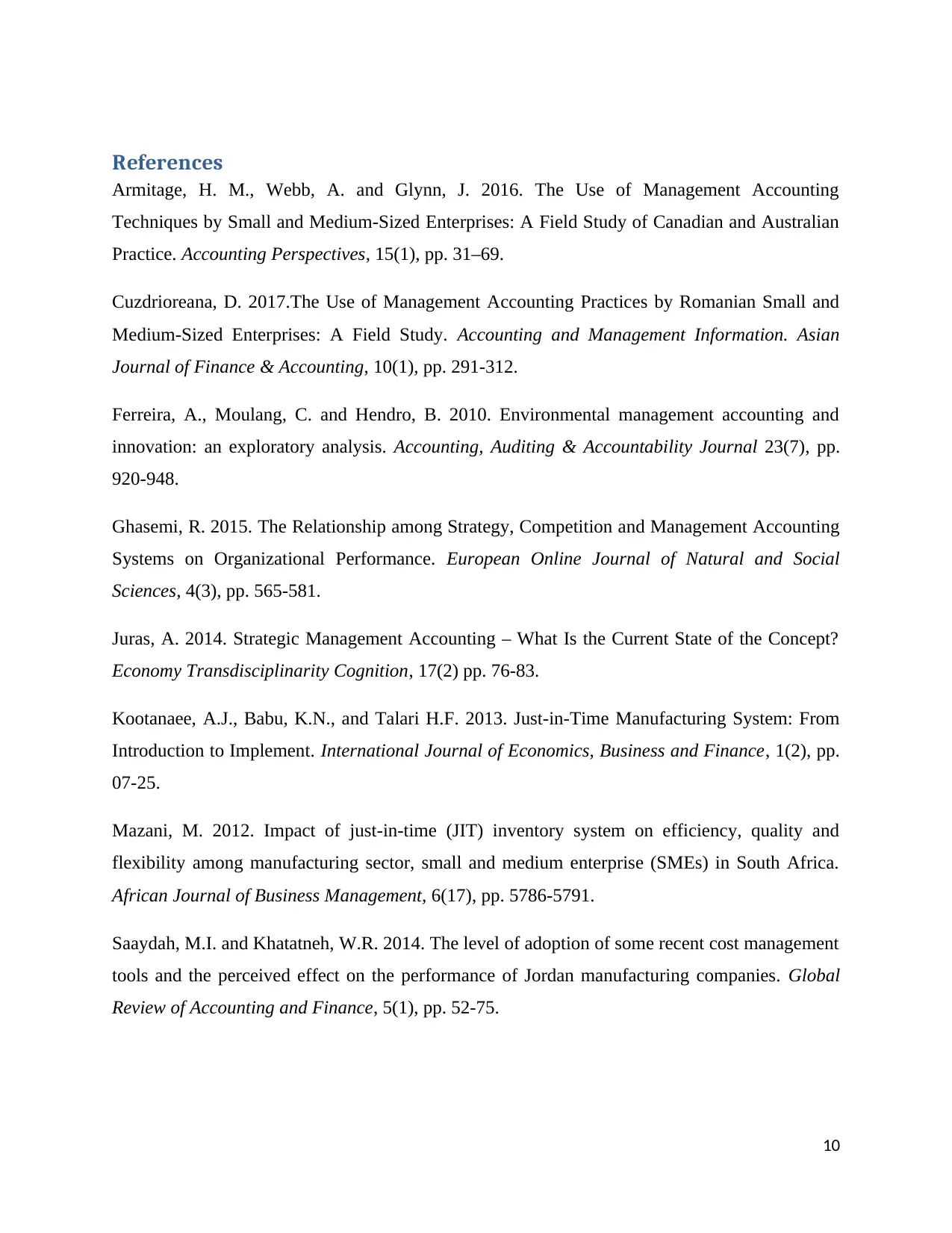
References
Armitage, H. M., Webb, A. and Glynn, J. 2016. The Use of Management Accounting
Techniques by Small and Medium‐Sized Enterprises: A Field Study of Canadian and Australian
Practice. Accounting Perspectives, 15(1), pp. 31–69.
Cuzdrioreana, D. 2017.The Use of Management Accounting Practices by Romanian Small and
Medium-Sized Enterprises: A Field Study. Accounting and Management Information. Asian
Journal of Finance & Accounting, 10(1), pp. 291-312.
Ferreira, A., Moulang, C. and Hendro, B. 2010. Environmental management accounting and
innovation: an exploratory analysis. Accounting, Auditing & Accountability Journal 23(7), pp.
920-948.
Ghasemi, R. 2015. The Relationship among Strategy, Competition and Management Accounting
Systems on Organizational Performance. European Online Journal of Natural and Social
Sciences, 4(3), pp. 565-581.
Juras, A. 2014. Strategic Management Accounting – What Is the Current State of the Concept?
Economy Transdisciplinarity Cognition, 17(2) pp. 76-83.
Kootanaee, A.J., Babu, K.N., and Talari H.F. 2013. Just-in-Time Manufacturing System: From
Introduction to Implement. International Journal of Economics, Business and Finance, 1(2), pp.
07-25.
Mazani, M. 2012. Impact of just-in-time (JIT) inventory system on efficiency, quality and
flexibility among manufacturing sector, small and medium enterprise (SMEs) in South Africa.
African Journal of Business Management, 6(17), pp. 5786-5791.
Saaydah, M.I. and Khatatneh, W.R. 2014. The level of adoption of some recent cost management
tools and the perceived effect on the performance of Jordan manufacturing companies. Global
Review of Accounting and Finance, 5(1), pp. 52-75.
10
Armitage, H. M., Webb, A. and Glynn, J. 2016. The Use of Management Accounting
Techniques by Small and Medium‐Sized Enterprises: A Field Study of Canadian and Australian
Practice. Accounting Perspectives, 15(1), pp. 31–69.
Cuzdrioreana, D. 2017.The Use of Management Accounting Practices by Romanian Small and
Medium-Sized Enterprises: A Field Study. Accounting and Management Information. Asian
Journal of Finance & Accounting, 10(1), pp. 291-312.
Ferreira, A., Moulang, C. and Hendro, B. 2010. Environmental management accounting and
innovation: an exploratory analysis. Accounting, Auditing & Accountability Journal 23(7), pp.
920-948.
Ghasemi, R. 2015. The Relationship among Strategy, Competition and Management Accounting
Systems on Organizational Performance. European Online Journal of Natural and Social
Sciences, 4(3), pp. 565-581.
Juras, A. 2014. Strategic Management Accounting – What Is the Current State of the Concept?
Economy Transdisciplinarity Cognition, 17(2) pp. 76-83.
Kootanaee, A.J., Babu, K.N., and Talari H.F. 2013. Just-in-Time Manufacturing System: From
Introduction to Implement. International Journal of Economics, Business and Finance, 1(2), pp.
07-25.
Mazani, M. 2012. Impact of just-in-time (JIT) inventory system on efficiency, quality and
flexibility among manufacturing sector, small and medium enterprise (SMEs) in South Africa.
African Journal of Business Management, 6(17), pp. 5786-5791.
Saaydah, M.I. and Khatatneh, W.R. 2014. The level of adoption of some recent cost management
tools and the perceived effect on the performance of Jordan manufacturing companies. Global
Review of Accounting and Finance, 5(1), pp. 52-75.
10
Paraphrase This Document
Need a fresh take? Get an instant paraphrase of this document with our AI Paraphraser
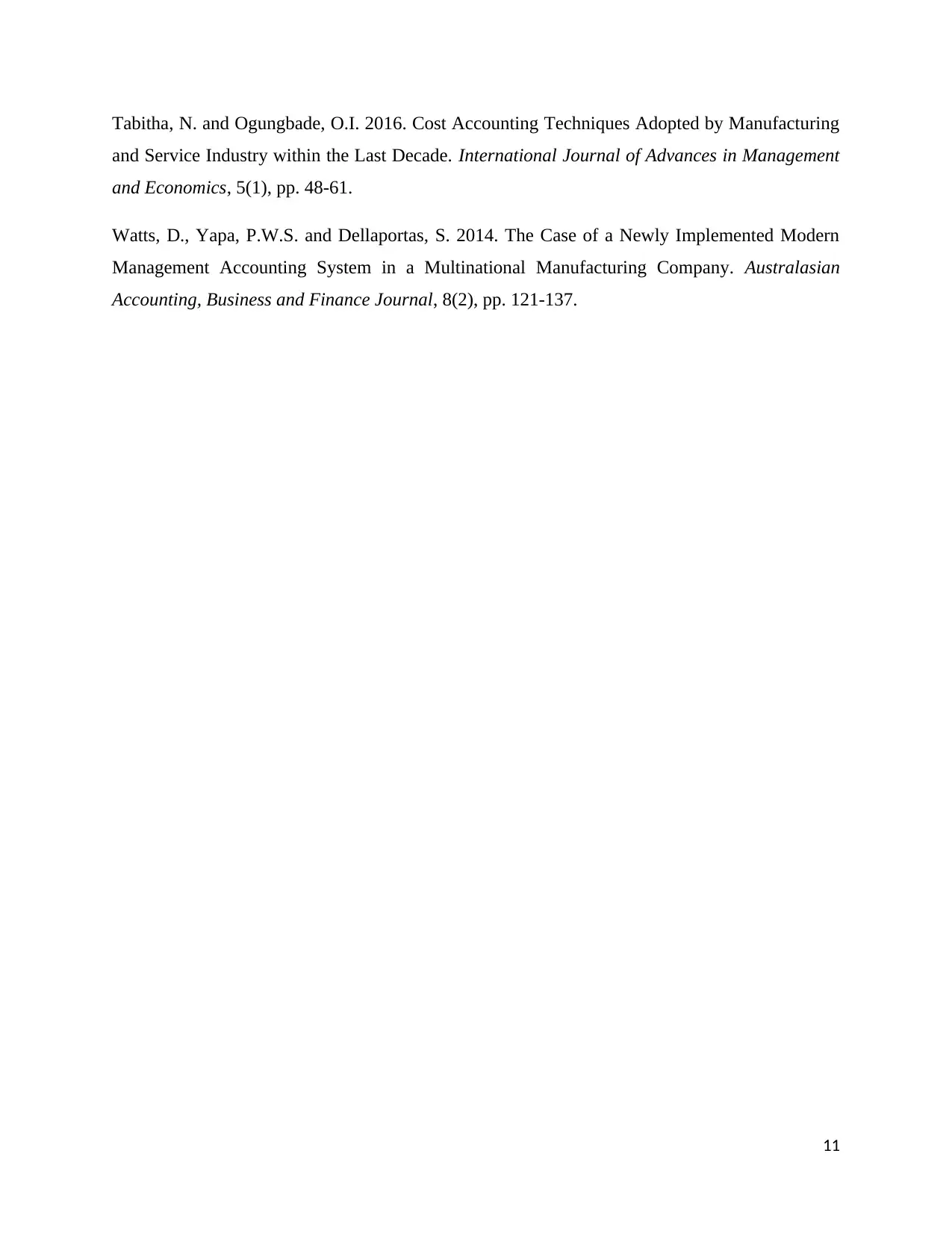
Tabitha, N. and Ogungbade, O.I. 2016. Cost Accounting Techniques Adopted by Manufacturing
and Service Industry within the Last Decade. International Journal of Advances in Management
and Economics, 5(1), pp. 48-61.
Watts, D., Yapa, P.W.S. and Dellaportas, S. 2014. The Case of a Newly Implemented Modern
Management Accounting System in a Multinational Manufacturing Company. Australasian
Accounting, Business and Finance Journal, 8(2), pp. 121-137.
11
and Service Industry within the Last Decade. International Journal of Advances in Management
and Economics, 5(1), pp. 48-61.
Watts, D., Yapa, P.W.S. and Dellaportas, S. 2014. The Case of a Newly Implemented Modern
Management Accounting System in a Multinational Manufacturing Company. Australasian
Accounting, Business and Finance Journal, 8(2), pp. 121-137.
11
1 out of 11
Related Documents
Your All-in-One AI-Powered Toolkit for Academic Success.
+13062052269
info@desklib.com
Available 24*7 on WhatsApp / Email
![[object Object]](/_next/static/media/star-bottom.7253800d.svg)
Unlock your academic potential
Copyright © 2020–2025 A2Z Services. All Rights Reserved. Developed and managed by ZUCOL.





